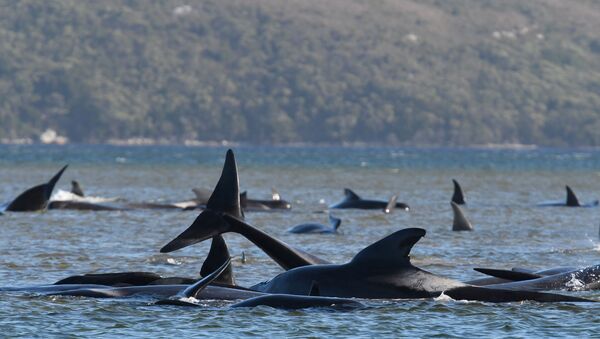According to a report by AFP, rescuers have saved some 50 whales out of a pod of around 460.
“We have got a more accurate count and we can confirm that 380 whales are dead,” said Nic Deka, a manager with Tasmania’s Parks and Wildlife Service, AFP reported.
“There’s around 30 left still alive, but the good news is that we have saved 50,” he added.
Officials first realized the pilot whales were stranded on sandbars inside the harbor on Monday, with a mass rescue effort taking place the following day.
A rescue crew consisting of 60 conservationists, local fish farm workers and volunteers has spent the last few days using boats with special slings to help free and guide the mammals back into the ocean.
Currently, the rescuers are focused on freeing as many of the remaining 30 live whales as they can.
“They’re focused on the job - it’s demanding work, some of them are up to their chest in cold water so we’re trying to rotate the crews,” Deka said.
“It's very draining physically. It’s also draining emotionally,” he added.
The whales have also been found stranded up to 6 miles apart, prompting officials to broaden their search area to determine if there are any more whales stuck nearby. In addition, some of the whales rescued Tuesday became stranded once again overnight, in accordance with what some whale behavior experts predicted, AFP noted.
“The good news is the majority of whales that were rescued are still out in deep water and swimming,” Deka told reporters. “They haven’t stranded. So we’ve been more successful than not.”
Although experts are unsure why mass strandings take place, some researchers believe the phenomena occur after pilot whales feed close to the shoreline or after following one or two whales that stray from the pod.
“We do step in and respond in these situations, but as far as being able to prevent these occurring in the future, there’s really little that we can do,” Tasmanian environment department marine biologist Kris Carlyon told AFP, referring to stranding as a “natural event.”
Officials will also have to dispose of the whale carcasses. Assessors will be developing a clean-up plan on Wednesday.
“As time goes on [the whales] do become more fatigued, so their chances of survival reduces,” Deka noted.
“But we’ll keep working as long as there’s live animals at the site,” he added.

